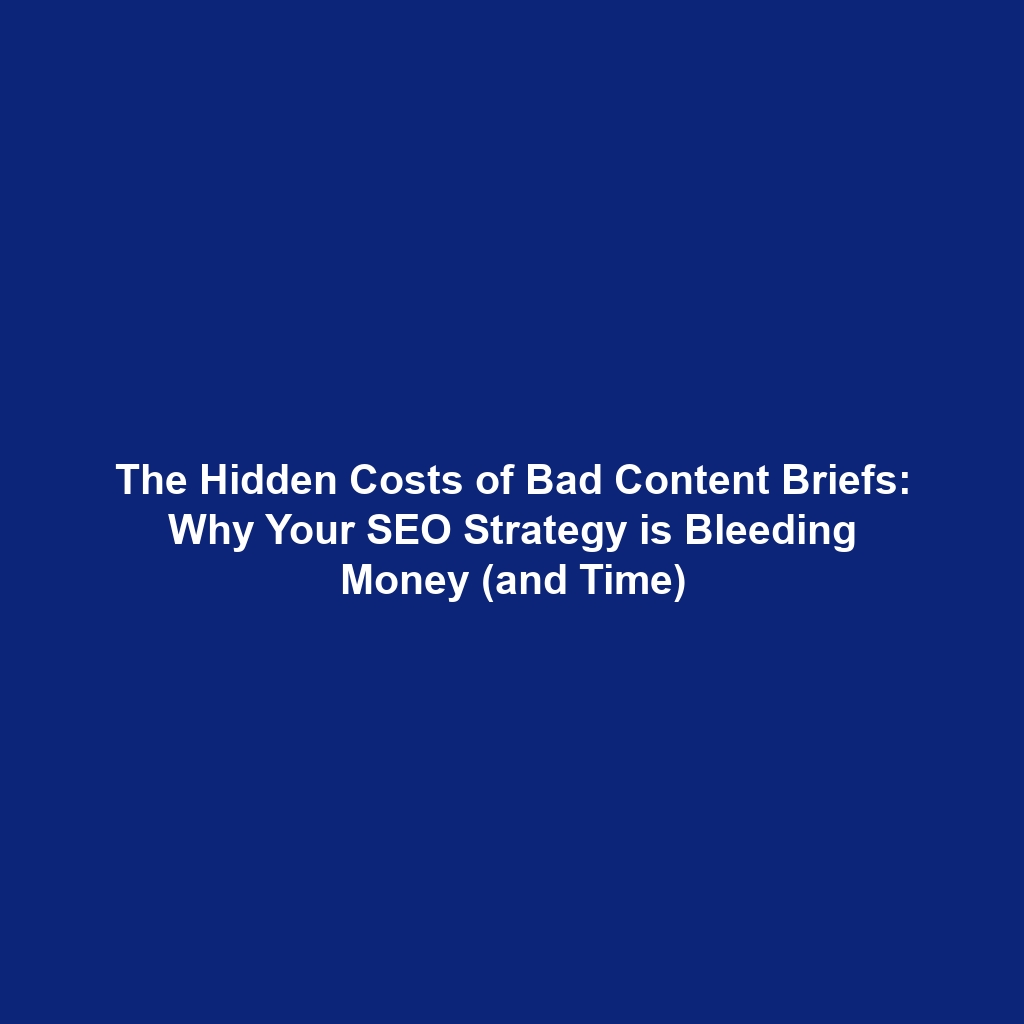Feeling swamped by content creation? You’ve got a brilliant idea, a burning desire to share it with the world, but then… crickets. Sound familiar? The problem often isn’t the idea itself, but the lack of a solid plan to bring it to life. That’s where content briefs come in. But let’s be real, who has time to meticulously craft a detailed brief for every single piece of content? That’s where the “under 60 seconds” part comes in! This post will show you how to create killer content briefs quickly, efficiently, and without the overwhelm.
The Pain of Poorly Planned Content
Think about the last time you tried to cook a complex meal without a recipe. Chaos, right? You might end up with something edible, but chances are it won’t be the masterpiece you envisioned. The same goes for content. Without a clear content brief, you risk:
- Wasted Time & Resources: Creating content that misses the mark, doesn’t align with your goals, and ultimately flops.
- Inconsistent Messaging: Your brand voice and tone can become diluted, confusing your audience.
- SEO Blunders: Missing crucial keywords and opportunities to rank in search results.
- Frustration: For both you and your team (if you have one). No one wants to guess what they’re supposed to do.
A good content brief acts as your recipe, guiding you from idea to a delicious (and effective!) piece of content.
Step-by-Step Guide to Lightning-Fast Brief Creation
Let’s get down to the good stuff: crafting a winning content brief in a flash. Here’s a streamlined process, focusing on the essential elements:
- Define Your Objective (10 seconds): What do you want this piece of content to achieve? Be specific. Are you aiming to generate leads, increase brand awareness, drive traffic to a specific page, or something else? Write it down.
- Know Your Audience (10 seconds): Who are you talking to? What are their pain points, interests, and what language do they use? If you don’t know who you’re writing for, you’re writing for no one.
- Choose Your Keyword (10 seconds): What keyword(s) will help your content get found? Research your target keywords and make sure they align with your objectives and audience interests.
- Outline the Key Sections (10 seconds): Jot down 3-5 main headings. Think about the flow of your content and the key information you want to convey. This is your content’s skeleton.
- Set Your Tone & Style (10 seconds): Is this a formal, informative piece, or a more casual, engaging one? Decide on your brand voice and any style guidelines you want to stick to.
- Call to Action (10 seconds): What do you want the reader to do after they’ve finished reading? Do you want them to subscribe, download a resource, or visit a product page?
That’s it! You’ve got a basic, yet effective content brief. Let’s see how this looks in practice.
Example Content Briefs for Different Platforms
Let’s tailor those steps to specific content formats:
Blog Post Brief:
- Objective: Increase organic traffic to the website and generate leads for a free content calendar template.
- Audience: Small business owners and content marketers looking to streamline their content planning.
- Keyword: “Content Calendar Template”
- Outline:
- Why You Need a Content Calendar
- Benefits of Using a Content Calendar Template
- Key Features of a Good Content Calendar
- How to Use the [Your Company Name] Content Calendar Template (with link to the download page)
- Tone & Style: Informative, helpful, and friendly.
- Call to Action: Download the free content calendar template.
Social Media Post Brief (e.g., LinkedIn):
- Objective: Increase engagement and build brand awareness.
- Audience: Marketing professionals and business owners.
- Keyword: #marketingtips #contentmarketing #socialmediamarketing
- Outline:
- (Quick hook related to a recent industry trend)
- Key Takeaway 1
- Key Takeaway 2
- Encourage discussion/ask a question
- Tone & Style: Professional and insightful, with a slightly conversational edge.
- Call to Action: Comment your thoughts!
Video Script Brief (e.g., YouTube):
- Objective: Generate views, build brand trust, and drive traffic to a product page.
- Audience: Potential customers interested in solving a specific problem.
- Keyword: “Product name review”
- Outline:
- Introduction: Problem statement and brief overview of the product.
- Key Feature 1 + Demonstration
- Key Feature 2 + Demonstration
- Pros and Cons
- Conclusion + Call to Action (link to product page)
- Tone & Style: Engaging, enthusiastic, and authentic.
- Call to Action: “Click the link below to learn more/try it for yourself.”
Advanced Tips for Supercharging Your Content Briefs
Want to take your briefs to the next level? Here are some optimization techniques:
- Competitor Analysis Snippets: Include links to a few top-ranking articles or videos related to your keyword. This helps you see what’s working and identify gaps in their content. (Think about the questions they’re not answering.)
- Word Count Range: Provide a suggested word count to give the content creator a sense of the content’s depth and scope.
- Example Headlines: Brainstorm a few potential headlines to spark creativity.
- Internal Linking Strategy: Identify relevant internal pages to link to within the content.
- Targeted Keywords: Include a list of related or long-tail keywords to optimize for.
Case Studies: Briefs in Action
Real-world examples speak louder than theory, so let’s look at how effective content briefs can drive results.
(Unfortunately, I cannot provide real case studies with the specifics of real companies. But I can guide you in what to look for when searching for them).
Scenario: Let’s say a small SaaS company uses detailed content briefs to guide their blog content creation. They target a specific keyword related to their product, creating a brief that includes a clear objective (generate leads), target audience (small business owners), and detailed outline. As a result of consistent and targeted content, the company sees a steady increase in organic traffic, lead generation, and ultimately, paying customers.
What to look for in a case study: Search online for case studies that are aligned with your niche or industry. Ideally, they’ll show before-and-after results (e.g., traffic increase, lead generation, sales growth) related to the implementation of a content strategy based on well-defined content briefs.
The Bottom Line: Content Briefs are Your Secret Weapon
Creating effective content briefs doesn’t have to be a time-consuming chore. By following the steps outlined above and customizing them to your specific needs, you can streamline your content creation process, improve your content’s quality, and see real results. Take the plunge and try it today! The time you invest in a well-crafted content brief will pay dividends in the long run.
For those looking for a content brief tool, check out Brief Buddy.


